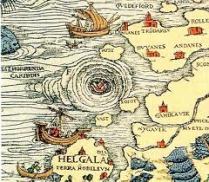Sometimes an image so thoroughly captures the spirit of the times that even the hyperventilated blogosphere must pause for a deep breath. Such is the grotesque image snapped by the honorable Ralf Dujmovits, depicting what he describes as a “human snake” ascending Qomolangma, or Holy Mother.
The mountain is known to western climbers as Mount Everest, named after a surveyor for the British Empire. {DP note: Sir George Everest actually opposed the name, on the grounds that it could not be written in Hindi nor pronounced by locals.} Once considered an expedition reserved only for the most skilled mountaineers, luxury adventure travel companies now offer Everest as a trophy destination available to anyone who can pay the piper.
Dujmovits had himself reached the South Col where, after assessing the deteriorating weather conditions, he made the correct decision to turn back. Among the most experienced and respected mountaineers in the world, Dujmovits was then astonished to see a lengthy human snake slithering up the Lhotse face.
Dujmovits described the scene in an interview with a reporter from the Guardian:
I was at around 7,900m and saw in the distance on the Lhotse face a human snake, people cheek by jowl making their way up. There were 39 expeditions on the mountain at the same time, amounting to more than 600 people. I had never seen Everest that crowded before.
I was thinking how absurd the scene was. Watching them, I had a strong feeling that not all of them would come back, and I wrote as much in my internet diary.
That leaves you with a really oppressive feeling that some of the people in the picture would soon be dead. I was also filled with sadness [for] this mountain, for which I have immense respect together with the experienced sherpas, that a great deal of that has been lost. People nowadays treat the mountain as if it was a piece of sporting apparatus, not a force of nature. It really makes my soul ache.
[Hobby climbers climb] just so that they can boast to their friends when they get back ‘I’ve climbed Everest’, like people who flash the Mercedes symbol around boasting that they’re rich enough to have one.

FACE OF THE SNAKE
In fact it takes no skill to do what most of the tourists to Everest do. The growing trend in the last 10 years has been to use oxygen almost from base camp onwards, whereas for decades it was only considered to be normal to use it from 8,000m onwards. Now they drink it like it was water.
[I saw] one overweight French journalist – a small woman weighing around 80kg, who had used her entire supply of oxygen before she’d reached any height at all, and an American of Turkish origin who was carrying his bicycle with him because it had always been his dream to take it to the summit and insisted on fulfilling that dream at whatever cost.
Nepalese organizations are picking their customers from the internet without any concern as to whether they are capable of the journey. I am anti-regulation, but I think the Nepalese government has little choice but to ask tougher questions of would-be climbers in future.
They should be asked to state which mountains they have climbed, to provide details of their fitness and to prove in general that they’re mountaineers.
Everest has been pushed to its limits, and a complete change of mind needs to take place otherwise we’ll see many more tragedies taking place. We need to debunk the myth of Everest.
It’s spoiled for me now. And it’s too dangerous. There are simply too many people on there who should not be there.
Elsewhere, in a press release from Boston Consulting Group we find:

The purchase of such experiences does not come without a price, such as the transformation of the noble Qomolangma into a high altitude garbage dump and deep freeze morgue.
Ralf Dujmovits has long been an advocate of climbing without the use of supplementary oxygen. In his view, oxygen-assisted climbs should not be counted as legitimate summits. In a prescient statement from 2006, he stated:
Personally as a climber, I’m convinced that we shouldn’t count climbs with supplementary oxygen as a real summit climb. That’s why I will return to Everest – my climb in 1992 was with O2. I had reached close to the South Summit without O2 a few days before; but had to turn back due to cold feet. I deeply respect everyone who climbs this big mountain – with or without O2. But I also see that an increasing number of people are trying to climb Everest with almost no climbing experience, or not fit enough to perform correctly in difficult circumstances. Both are essential conditions in mountain climbing.
Six years later, he returned to the South Col (without oxygen) and witnessed the perverse spectacle of the human snake: clueless tourists sucking on their O2 canisters, greedily consuming the Holy Mother, wholly oblivious to her nature.

HUMAN SNAKE EXCREMENT





